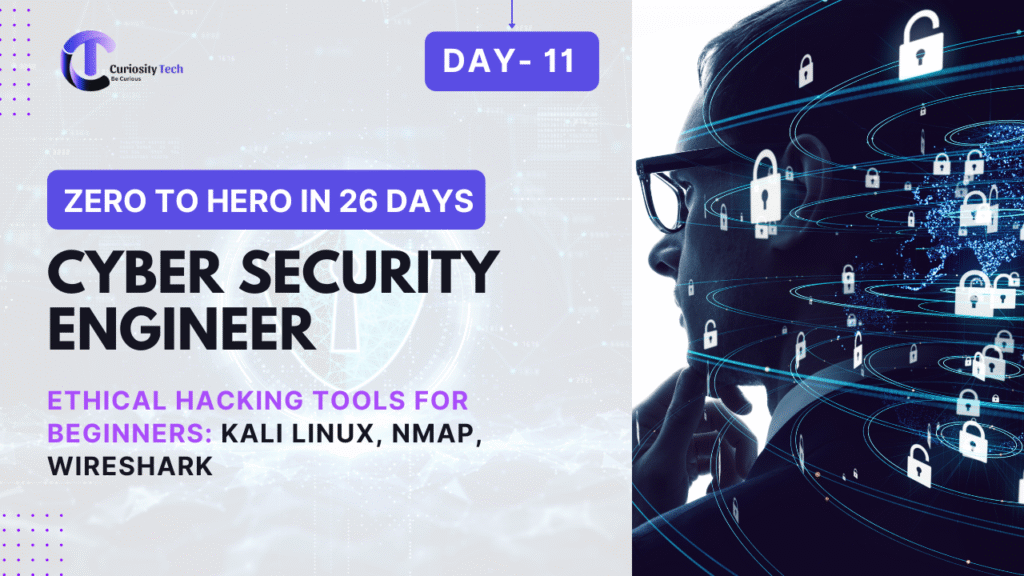When I first picked up ethical hacking nearly 18 years ago, the biggest challenge wasn’t understanding vulnerabilities—it was learning the tools professionals use to discover and analyze them. In modern cybersecurity, tools are the weapons and microscopes of the trade. Without them, ethical hackers see only the surface of the digital world. With them, hidden weaknesses suddenly come to light.
At CuriosityTech.in Nagpur, beginner engineers often ask: “Which tools should I start with?” While the hacking toolkit is vast, the “holy trinity” for every beginner remains the same: Kali Linux, Nmap, and Wireshark.
In this article, I’ll introduce these tools in a structured manual guide format—purpose, installation, hands-on demo, typical outputs, and learning exercises.
Tool 1: Kali Linux – The Ethical Hacker’s Operating System
Purpose
Kali Linux is a Debian-based Linux distribution built specifically for penetration testing and security research. Packaged with over 600+ tools, it is the Swiss Army knife of hackers.
Key Features
- Preloaded tools: Nmap, Metasploit, Burp Suite, Nikto, Aircrack.
- Updated regularly with security patches and vulnerability tools.
- Supports live USB, VM installation, and WSL for Windows users.
Lab Installation Demo
- Download Kali ISO → Install on VirtualBox or VMware.
- Set up VM with at least 2GB RAM, 2 CPUs.
- Login credentials (default): user: kali / password: kali.
Hands-On Exercise in CuriosityTech Labs
- Open terminal → Run apt update && apt upgrade to update tools.
- Explore /usr/share/kali-menu/ to view preinstalled tools.
- Run msfconsole to launch Metasploit Framework.
Real-World Use Case
During a penetration test on a college network, our engineers at CuriosityTech spun up Kali Linux and immediately had access to Wireshark, Nmap, and exploit databases—all in one environment.
Tool 2: Nmap – The Network Mapper
Purpose
Nmap is the go-to tool for network scanning and discovery. Ethical hackers use it to identify live hosts, open ports, running services, and potential vulnerabilities.
Command Flow Walkthrough
- Simple Host Discovery
- Command: nmap 192.168.1.1
- Output: Tells if host is alive & basic services.
- Port Scan
- Command: nmap -p 1-1000 192.168.1.10
- Output: Lists open ports (e.g., 22 for SSH, 80 for HTTP).
- Service & Version Detection
- Command: nmap -sV 192.168.1.10
- Output: Reveals software versions—useful for finding vulnerable builds.
- Aggressive Scan (OS Detection)
- Command: nmap -A 192.168.1.10
- Output: Detects OS type, traceroute, and service banner info.
Learning Exercise
In CuriosityTech labs, we simulate two VMs:
- VM1 = Attacker machine (Kali Linux with Nmap).
- VM2 = Victim machine (Linux server running Apache).
Students run scans, identify ports, and verify attack surface.
Real-World Use Case
An SME in Nagpur believed its FTP (Port 21) was closed. An Nmap scan revealed it open. Worse, anonymous login was enabled—leaving all files exposed. Without Nmap, this critical weakness would have been invisible.
Tool 3: Wireshark – The Packet Analyzer
Purpose
Wireshark is a network protocol analyzer that captures and inspects live traffic. Think of it as an X-ray machine for packets. While Nmap finds “where doors are,” Wireshark spies what’s travelling through them.
Features
- Capture network packets in real time.
- Decode >2000 protocols (HTTP, TLS, DNS, SMB, etc.).
- Search, filter, and reconstruct entire conversations.
Hands-On Capture Demo
- Open Wireshark → Select network interface (e.g., eth0, wlan0).
- Start Capture → Visit website http://testphp.vulnweb.com.
- Filter DNS traffic: dns. Observe name resolution queries.
- Filter HTTP traffic: http. Check unencrypted GET requests.
Output Example
- Request: GET /login.php HTTP/1.1
- Response: 200 OK with visible credentials in legacy servers.
Security Implication
Without HTTPS, usernames and passwords are visible to any attacker sniffing packets on open Wi-Fi.
Real-World Case
In 2012, while auditing a university Wi-Fi in Nagpur, we demonstrated how students logging into email without TLS had their passwords visible in plaintext via Wireshark. That incident convinced the administration to migrate to secure email protocols.
Quick Tool Comparison Matrix
| Tool | Category | Best for Beginners | Example Use |
| Kali Linux | OS / Suite | All-in-one hacking toolkit | Launching multiple preloaded tools |
| Nmap | Network Scanning | Learning ports/services | Identify open SSH, HTTP ports |
| Wireshark | Packet Analysis | Understanding traffic flows | Inspect DNS queries or stolen credentials |

Infographic Description
A toolbox-styled infographic:
- Kali Linux Box: Contains multiple tools (icons for Nmap/Wireshark inside).
- Nmap Scanner Light Beam: shining on hosts, identifying open ports.
- Wireshark Magnifying Glass: zooming into individual packets travelling across network cables.
This visual would reinforce the hierarchy: Kali (Platform) → Nmap (Discovery) → Wireshark (Deep Analysis).
Mistakes Beginners Often Make
- Over-relying on tools without interpreting results.
- Running scans on unauthorized targets—ethical boundaries matter.
- Ignoring packet encryption: Wireshark won’t reveal HTTPS payloads without deeper setup.
- Forgetting to update tools—outdated signatures miss vulnerabilities.
Conclusion
Kali Linux, Nmap, and Wireshark form the starter toolkit every cyber engineer must master. Together, they provide a launchpad: an environment (Kali), a radar (Nmap), and a microscope (Wireshark). Knowing these tools transforms beginners from passive learners into ethical hackers ready to navigate the digital battleground.
At CuriosityTech.in (Address: Plot No 81, Wardha Rd, Gajanan Nagar, Nagpur | Phone: +91-9860555369 | Email: contact@curiositytech.in | Socials: Instagram @curiositytechpark, LinkedIn & Facebook: Curiosity Tech), every student lab starts with these three tools. Because once you know how to scan and see the invisible, you’ll never look at networks the same way again.

